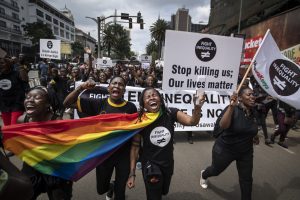By Hannah Ryder
 In this Friday, Jan. 17, 2020 file photo, demonstrators calling for an end to the “age of greed” march to the office of the president in downtown Nairobi, Kenya.Credit: AP Photo/Ben Curtis, File
In this Friday, Jan. 17, 2020 file photo, demonstrators calling for an end to the “age of greed” march to the office of the president in downtown Nairobi, Kenya.Credit: AP Photo/Ben Curtis, File
“It’s like they grab you by the neck and pin your back to the wall,” the ambassador said.
We were having a fairly candid discussion about negotiations with a lender over his country’s debt levels, a country that had, by then, raised debt from all over the world – the private sector through Eurobonds, multilateral lenders, as well as bilateral lenders and China, too. And I understood. That fear of being helpless, unable to move, is what a number of politicians, government representatives, and diplomats around the world are concerned about right now, as the COVID-19 pandemic spreads.
Opinion shapers, experts, and journalists are using phrases such as debt crisis, debt diplomacy, debt relief, debt forgiveness, and debt moratoriums. Countries with alleged “debt problems” are being downgraded by ratings agencies. In February 2020, even before revising global growth forecasts due to COVID-19, the International Monetary Fund (IMF) classified half of low-income countries (LICs) around the world as already “debt distressed” or at high risk of becoming so. There have been specific calls for China, as a lender reported to play a huge role in many countries’ debt positions, to cancel or at least suspend requests for debt payments.
Are these concerns backed up by facts? And what is the solution for Asian, African, and other developing countries – including those part of China’s Belt and Road Initiative (BRI)?
Of all the solutions being discussed so far, including those seen as fairly radical, none address the fundamental problem of helplessness the ambassador shared in our candid conversation years ago.
The right solution is a re-imagining of the debt system to have borrowers “club together.”
Most Poor Countries Are in Debt to Others – And Need to Be
I am loath to use the analogy of the individual in debt to extrapolate to a country level, but in order to explain the complexities being generated by the COVID-19 crisis for countries in debt, I think it might just be helpful.
The majority of individuals across the world have debt, from microloans to mortgages. So do the majority of governments. Both rich and poor governments, on behalf of their citizens, have debt. For most rich country governments, their debt is often lent from within their own countries – their own central banks, or their own private banks. But for most poor country governments, the debt has been lent to them from external sources – by other governments and multilateral organizations, as well as private lenders.
Why do they need debt? Just like individuals often can’t manage to pay for university (student loans), a new business, or even a new home (mortgage) upfront, governments often need debt to pay for roads, trains, new housing projects, or to invest in the quality of their education or health systems. The African Development Bank has estimated that African countries cannot raise taxes or other funds domestically for basic infrastructure needs valued at over $68 billion per year, let alone all the other key requirements of their citizens. Asia is better placed, but still has major financing gaps, estimated at $141 billion per year.
China is already filling some of this gap.
No comments:
Post a Comment